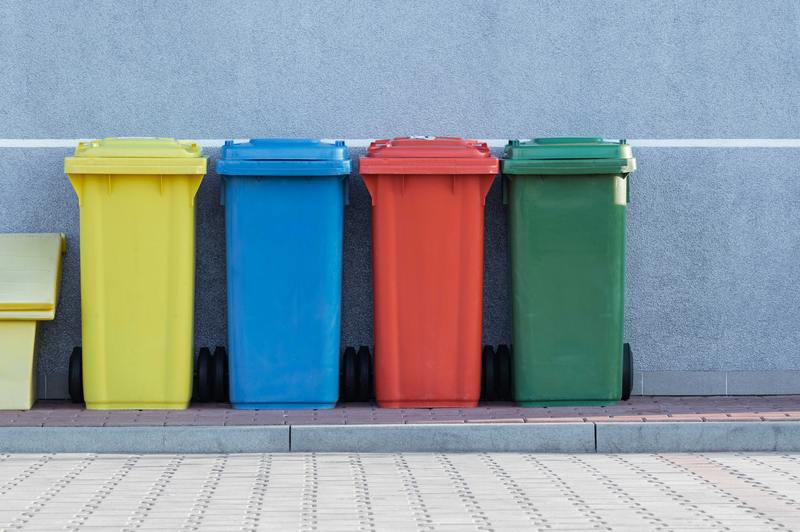If you ever wonder “why is there mildew in trash cans”, the answer is humidity and food source. Read all about these two and how to remove mildew below.

What Is Mildew?
Mildew is what you get when you have a moisture-rich environment with organic debris build-up. There are two forms of mildew: powdery and downy.
In contrast to mold’s fuzzy and slimy texture, mildew is less noticeable and gross-looking. However, this makes mildew less alarming, which leads to them being left unattended.
Untreated mildew problems lead to multiple issues. One of them concerning health, despite being milder than mold, can still trigger skin allergies or respiratory symptoms.
Another concern for unattended mildew is making the environment perfect for mold to grow. Mildew alone can be pretty damaging to your furniture and indoor plants; couple it with mold, and it will be devastating.
Moreover, mold infestation could lead to more repair costs. These are generally more expensive than DIY mildew removal expenses.
Check out how much does a mold inspection cost in the linked article. This could help you understand just how much mold removal costs.
How Does Mildew Develop In Trash Cans?
Trash cans are perfect environments for mildew. This is because there is organic debris there.
Moreover, trash cans are closed areas that do not get airflow and sunlight. These characteristics serve as an invitation to mildew spores to grow in the trash bins.
From mildew spores, the mildew would develop and grow. It will thrive in the trash can because of its environment, eventually leading to mold growth.
What Is The Danger Of Letting Mildew Form In Trash Cans?
The odor from trash cans is not surprising because they contain waste. However, the musty smell of mildew gets covered up by the foul scent.
This is concerning since smell is the best way to identify mildew growth.
Also, it is not right to sniff the trash can to check if there’s mildew, nor would anyone volunteer to look into it to fit. This lack of options to detect mildew growth inevitably leads to mildew colonies in the bin.
If left unattended, the mildew from trash cans can spread to other areas of your house. It could reach your cabinets and infect them and the things in them.
For your reference, we linked an article on how to prevent mildew in cabinets. However, please note that if the source of mildew growth is not the cabinet itself, the mildew may come back and infect it again.
Apart from cabinets, the mildew spores from the trash can could also get into your food. A small amount would not make a noticeable difference, but prolonged exposure does have some adverse effects.
Lastly, mildew could also invite mold to grow in the trash cans. If so, the threat to your health increases as there is a possibility that toxic mold could grow in your garbage can.
How To Remove Mildew From Trash Cans
Untreated and mildew-contaminated trash cans can be a health risk, so it’s only fitting to know how to clean them. Here are the steps:
Step #1. Prepare the materials
For this mildew removal process, you will need paper towels, old rags, rubber gloves, bleach or ammonia (do not use both), water, a long-handled brush, an all-purpose cleaner, and a face mask.
To protect yourself from the cleaning solutions and the mildew in the trash can, wear rubber gloves.
Step #2. Empty the garbage can
Before cleaning, remove all the can contents and put the contents in a black plastic bag. Make sure you seal the bag properly not to let any mold spores out.
Step #3. Rinse the can
Move the trash can outdoors and rinse it with a hose. Ensure that you eliminate as much residue as possible.
Afterward, fill the can with a quarter of hot water. Then, pour either bleach or ammonia.
Please do not mix the two solutions as you will have a toxic fume. Then, let the mixture soak in the garbage can for several hours.
Step #4. Brush away
After soaking the can and removing the residue, scrub the inside of the trash can thoroughly. Pay extra attention to the trash can’s edges and corners as there might be mildew.
Step #5. Dispose and dry
Dispose of the cleaning solution and dry the trash can with a clean cloth. Let it air-dry or dry under the sun to remove the remaining bacteria.
How To Prevent Future Mildew Growth On Trash Cans
The best way to prevent future mildew growth is to use high-quality trash bags. Garbage bags can help prevent leakage and minimize the gunk that comes in contact with your trash can’s surface.
Another way to prevent future mildew growth is regular cleaning. You can use bleach wipes for frequent and quick cleanings.
There should also be deep cleanings of trash cans at least once a month. Whenever you notice a foul odor, it’s typically the time for a deep clean.
Conclusion
To conclude, the answer to why is there mildew in trash cans is because of its damp environment. We tackled that in this article and the ways to remove it.
We hope everything about this mildew-related article was helpful!
